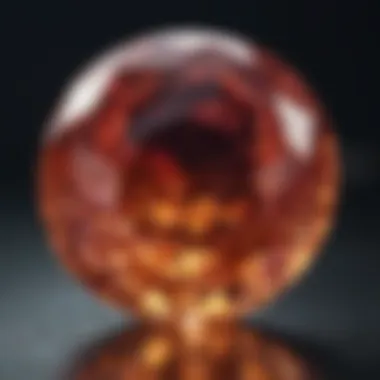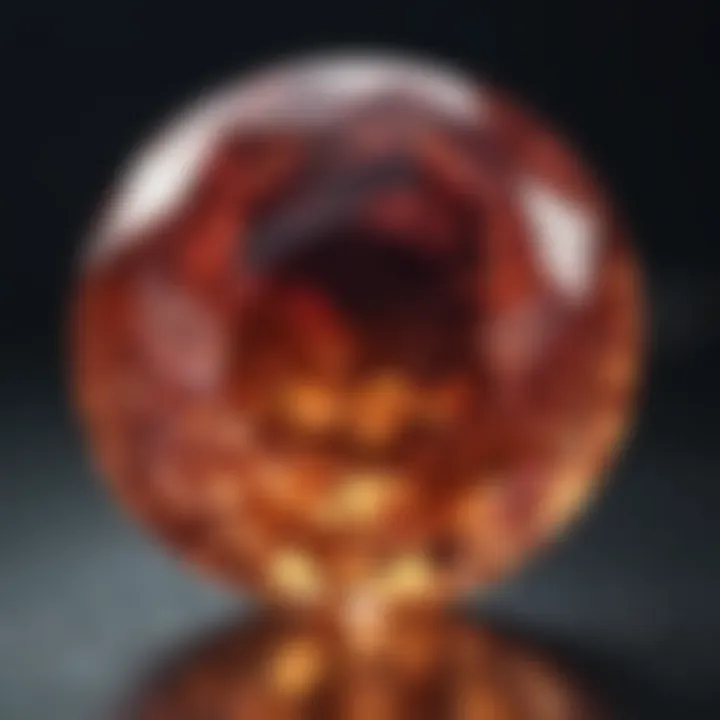Understanding I1 Grading in Gemstone Clarity


Intro
In the fascinating world of gemstones, clarity stands as one of the pivotal factors influencing both their beauty and value. Among the various grading systems used to evaluate clarity, the I1 (Included 1) grade often stirs up curiosity and varied opinions, especially amongst collectors and gem enthusiasts. This isn’t just about spotting flaws; it's a journey into understanding how those imperfections contribute to the overall allure of a stone. In this discussion, we’ll navigate through the labyrinth of stone clarity, shine a light on I1 grading, and dissect its impact on aesthetics, valuation, and collector interest.
Gemstone Overview
Definition and Origins
Gemstones, wondrous creations of nature, exhibit a stunning variety of colors, shapes, and sizes. They are mineral formations, often cut and polished to be used in jewelry and decoration. Their allure has captivated humanity for millennia. The term ‘gemstone’ generally applies to any precious or semi-precious stone which has been cut and polished to enhance its beauty, making it ready for adornment.
The origins of gemstones often trace back to geological processes. Many are formed deep in the Earth’s crust under extreme heat and pressure, while others undergo long weathering processes. Each gemstone carries with it not just physical beauty, but a story of its formation and the journey it took before it reached the jeweler’s bench.
Historical Significance
Throughout history, gemstones have been esteemed for their beauty and rarity. The ancient Egyptians cherished lapis lazuli for its deep blue hue, believing it brought protection and wisdom. The Romans adorned themselves with garnets and emeralds, indicating wealth and stature. Over the decades, gemstones have also played a vital role in trade and economy, influencing cultures and societies across the globe.
Their significance transcends mere decorations; they are embedded in traditions, religious practices, and even in scientific realms such as geology and gemology. For many cultures, gemstones symbolize power, love, and protection, forming the backbone of various myths and legends.
Gemstone Properties
Hardness and Durability
When it comes to evaluating gemstones, hardness and durability are paramount. The Mohs scale, ranging from 1 to 10, gauges a gemstone's ability to withstand scratching. Diamonds, for instance, score a perfect 10, making them exceedingly durable. In contrast, softer stones like talc score a mere 1, making them less suitable for everyday wear.
Understanding hardness is critical for both jewelers and buyers alike. A softer stone might be exquisite, but it requires more care and cautious handling than its hardened counterparts, making it less practical for everyday jewelry.
Color and Clarity
Without a doubt, color serves as a major first impression of any gemstone, but clarity holds just as much weight in concrete valuation. Clarity refers to the absence of internal or external flaws, or 'inclusions'. While a flawless stone might fetch a higher price, many enthusiasts appreciate how inclusions can tell a stone's unique tale. An I1 graded gemstone contains inclusions that are noticeable without magnification, yet these imperfections can occasionally enhance the character of the stone rather than detract from it.
Key Factors in Clarity Determination:
- Inclusion Type: Some inclusions are more severe than others.
- Location of the Inclusions: Position can make a difference in the aesthetic appeal.
- Size of the Flaws: Larger inclusions typically reduce value more than smaller ones.
In the realm of gemstones, the dance between color and clarity is what creates a captivating piece. A gemstone's clarity can affect its overall look and feel, transforming it from a mere decoration to a piece of history and rarity.
"A gemstone’s clarity tells the story of its journey through time and nature, lending it both beauty and character."
Gemstone enthusiasts, jewelry designers, and collectors alike understand that every stone tells a distinct narrative. Whether you are drawn to the precise hues of sapphires or entranced by the mystique of emeralds, the quest for understanding their properties is an engaging and enlightening experience. As we delve further into the nuances of I1 grading, we’ll explore its implications for both valuation and aesthetics, enlightening your journey into the vast world of gemstones.
Understanding Stone Clarity
Understanding stone clarity is fundamental in the world of gemstones. When talking about clarity, we're digging into a certain aspect that tells us how transparent a stone is, as well as how many imperfections, if any, might be lurking beneath the surface. This isn't just a matter of aesthetics; it carries significance well beyond appearances. Gemstone enthusiasts, collectors, and jewelry designers place enormous value on clarity, so grasping this concept is essential when navigating the intricate market.
Defining Clarity
Clarity refers to the presence of internal or external flaws—often likened to the blemishes on a person's face that can either enhance character or detract from beauty. In the gemstone realm, clarity can be defined as the degree to which a stone is free from these inclusions or blemishes. These characteristics can affect a gem's brilliance, sparkle, and overall visual harmony.
Within the clarity spectrum, inclusions can be anything from air bubbles to fractures, or even minerals trapped within the gemstone during its formation. Understanding the specifics can help potential buyers make informed choices, guiding them in their quest for the perfect stone.
Importance of Clarity in Gemstones
When it comes to gemstones, clarity is often seen as a key player in determining value. A stone with higher clarity typically garners a higher price tag. This relationship is noticeable especially in diamonds, where clarity is one of the four C's—cut, color, clarity, and carat weight—that define a stone’s quality.


But it's not always just about the dollar signs. Clarity also influences the stone's visual appeal. A clearer gemstone tends to play with light more effectively, causing a sparkling effect that many buyers find desirable. In contrast, an I1 clarity grade indicates that significant inclusions may be visible to the naked eye, which could turn potential buyers away.
While some collectors may be drawn to unique or unusual inclusions as a signature of character, others might find them distracting. Thus, the conversation surrounding stone clarity often extends beyond mere valuation; it highlights individual preference as well.
The implications of clarity stretch into the very core of gemstone appreciation, influencing not just purchases, but also the understanding of the stone's journey through time.
In summary, clarity isn’t just a characteristic to tick off a checklist; it’s a nuanced, layered topic that lays the groundwork for a rich conversation about value, beauty, and personal choice in gemstones. As we delve into I1 grading specifically, this understanding of clarity will set the stage for appreciating what makes these stones unique.
The Grading Scale Explained
Understanding the grading scale is crucial for any serious gemstone enthusiast, collector, or designer. Specifically, it provides a structured way of assessing the qualities that contribute to a gemstone’s overall beauty, desirability, and ultimately, its value. The grading scale offers insights not just into clarity but also into aspects like color, cut, and carat weight. This is particularly relevant when we consider I1 grading—one of the more nuanced classifications that can often be misunderstood.
The grading scale serves as a universal language among gem professionals. It provides a framework to talk about stones in an objective manner. Each grade reflects certain criteria that allow both sellers and buyers to make informed decisions. The importance of knowing where a stone falls on this scale can't be overstated; it can make the difference between selecting a cherished piece of jewelry and investing in a misunderstanding.
Additionally, the grading scale helps to standardize the way gemstones are evaluated. This reduces anecdotal assessments, which can be quite subjective, and allows everyone involved to share a common understanding. When it comes to discussing I1 clarity, recognizing how it fits within the broader grading system can paint a more complete picture of what to expect visually and financially.
Prolusion to Gemstone Grading
Gemstone grading is a systematic approach to assessing the characteristics of gems. It involves categorizing stones based on established criteria. This method not only promotes transparency but also establishes trust within the marketplace. Various organizations, such as the Gemological Institute of America (GIA), have developed grading systems that are widely recognized.
The grading process evaluates several key factors, but a closer look at clarity reveals some critical points to consider. Gemstone clarity is primarily concerned with the inclusions and blemishes present within a stone. These imperfections can affect how light interacts with the gem, ultimately influencing its overall appearance.
Overview of Clarity Grades
Clarity grading consists of several classifications, each denoting a specific level of inclusiveness. Ranging from Flawless (FL) to Included (I), the scale helps assess how clear a gemstone appears to the naked eye. Here are a few common grades:
- Flawless (FL): No inclusions visible under 10x magnification.
- Very Very Slightly Included (VVS1 and VVS2): Inclusions are very difficult to see even under 10x magnification.
- Very Slightly Included (VS1 and VS2): Inclusions are visible under 10x magnification but not usually to the naked eye.
- Slightly Included (SI1 and SI2): Inclusions are noticeable under 10x, and some may be visible to the eye.
- Included (I1, I2, I3): Inclusions are obvious and can materially affect the overall appearance of the stone.
In this context, I1 represents a classification where inclusions are noticeable and may impact the stone’s brilliance and overall aesthetic appearance. Understanding where I1 fits within this spectrum will arm buyers with the knowledge to make better investment decisions.
I1 Clarity Defined
Understanding I1 clarity is key for anyone in the gemstone world. I1, which stands for Included 1, tells you a lot about the stone's visual appeal and market value. This designation is more than just a grade; it represents how inclusions impact the stone’s beauty and its worth. In this context, knowing what I1 means can help buyers make informed decisions, whether they are collectors, jewelers, or just someone looking for that special piece.
Characteristics of I1 Grading
When it comes to I1 grading, the characteristics are fairly distinctive.
- Inclusivity: I1 stones can have visible inclusions. These inclusions are more significant than what you would find in higher grades. Think of it like a blemish on a perfect apple.
- Eye-visible Defects: Under normal viewing conditions, you can spot these inclusions with the naked eye. They may detract from the overall aesthetic appeal, but they also tell a story about the stone's natural origin.
- Cut and Polish: The cut quality can sometimes diminish the visibility of these inclusions. A well-cut I1 stone might still shine brightly, even with flaws.
The take-home point here is that I1 clarity doesn’t necessarily mean a stone is worthless. It can still possess beauty and charm in its own right, even if it shows signs of inclusivity.
Visual Indicators of I1 Clarity
Identifying I1 clarity is much like spotting an irregularity on a freckled face. It may not be perfect, but it has its own unique charm. Here are some visual cues to look for:
- Inclusion Color: Inclusions can vary in color, from black to white or even another gemstone tone. This can affect the stone's overall appearance. Dark inclusions often stand out more starkly against lighter stones.
- Pattern: The pattern of inclusions can also serve as a visual indicator. Whether they form webs, clouds, or specks, each pattern tells a different story about the stone’s formation.
- Light Reflection: Sometimes, inclusions can scatter light in interesting ways. This can add a certain character to the stone but might also reduce its brilliance compared to higher clarity grades.
"I1 stones, while not perfect, can offer a unique beauty that’s often overlooked. Each inclusion tells a story of the Earth’s geological journey."
Keeping an eye on these factors will help you appreciate the uniqueness of I1 stones. They aren’t just lesser-quality gems; they're simply a different chapter in the story of stone formation. Their visual characteristics make them a fascinating choice for jewelry designers and collectors alike.
Factors Influencing Clarity Grading


Understanding the factors that influence clarity grading is essential for gemstone enthusiasts, collectors, and anyone interested in the finer aspects of gemstones. Clarity is not just about how a stone looks; it’s about appreciating the nuances that can determine a stone's fate on the market. A gemstone's clarity can dramatically affect its value, aesthetic appeal, and overall desirability. This section will dissect the main factors, both innate and external, that play a role in determining clarity grades, especially focusing on I1 stones.
Innate Characteristics of the Stone
Every gemstone is unique, much like a fingerprint. The innate characteristics refer to the natural qualities of the stone itself. Inclusitions, or internal flaws, are the primary concern when assessing clarity. I'll give you an idea about how these inclusions can appear. Imagine a diamond that has a small speck of carbon trapped inside; although it may seem insignificant, this tiny blemish can lower the stone's clarity grade considerably.
Inclusions can vary not just in type but also in size, number, and even location. For example, inclusions located near the center of the stone may be more noticeable than those found at the edges. It’s like trying to hide a pimple on your nose instead of one on your cheek; it's just tougher to pull off!
On top of that, gemstones hold their appeal from their natural color and pattern. Stones naturally clearer like aquamarine or certain colorless diamonds may command better grades than inherently included stones. Thus, knowing what a specific stone typically harbors in terms of internal attributes can help in understanding its clarity grading better.
Cut Quality and Its Role
Now let’s talk about cut quality, which might be the unsung hero in the clarity grading arena. An excellent cut can make a less-than-perfect gemstone appear more brilliant. It's all about how the stone interacts with light. When a gemstone is cut properly, it can hide some inclusions and bring out the color in a way that distracts the eye from flaws. The geometry, proportions, and polish of the cut can significantly enhance the way a stone reflects and refracts light.
A well-cut I1 stone might sparkle enough to make you forget about its clarity imperfections, while a poorly cut stone, even if it has a higher clarity grade, could look dull and lifeless. Think of it like having a beautiful dress but choosing the wrong shoes to go with it; the whole look can fall apart!
The Impact of I1 Clarity on Value
The I1 clarity grade, known for its noticeable inclusions and slight visibility, plays a crucial role in determining the value of gemstones. When evaluating a stone's market value, clarity is not just a footnote in a sales pitch—it can be a game changer. Stones with different clarity grades evoke different perceptions among collectors and jewelers alike, ultimately driving prices and desirability.
The implications of I1 clarity are multifaceted, particularly in how they resonate with both collectors and casual buyers. It's not just about whether a stone shines bright or looks dull; it's about the stories the inclusions tell and how they fit into the broader market trends. Clarity can influence not only the price but also the stone's use in jewelry and its appeal to enthusiasts.
Market Perceptions of I1 Grade Stones
The perceptions surrounding I1 grade stones can be quite mixed. For some, the visible inclusions serve as a mark of uniqueness, while others might view them as imperfections that diminish a stone’s value. This divergence in opinion creates an interesting dynamic in the market.
- Unique Character: Many collectors appreciate I1 stones for their individuality. The inclusions highlight the natural story of the stone’s formation, making each specimen unique.
- Affordability: I1 clarity stones are often more budget-friendly compared to higher clarity grades. For many, this opens doors to owning beautiful gemstones without the heart-stopping price tag.
- Market Trends: Some market segments are currently leaning towards preferring natural-looking stones with visible inclusions over flawless options, as they promote authenticity. Gems that exhibit this trend are altering traditional perspectives, emphasizing the aesthetic charm these stones bring.
As a result, the trade of I1 stones isn't just a gamble; it can be a pathway to collecting gems that are unique and affordable, intertwining craft and character in a way that speaks to many.
Pricing Dynamics for I1 Clarity Gemstones
Pricing for I1 clarity gemstones is a careful balancing act influenced by several factors. Understanding these elements provides crucial insights into making informed purchases or investments.
- Availability: I1 stones are generally more prevalent in the market than their higher clarity counterparts, which affects pricing. The larger supply means lower prices but also increases competition.
- Demand for Unique Features: Interestingly, some buyers prefer inclusions as they signify authenticity, thus propelling the market price upward. This phenomenon has led to a gradual reassessment of how I1 clarity stones are valued in niche markets.
- Jewelry Context: When discussing prices, context matters, especially in jewelry. I1 stones can be particularly attractive when set in custom pieces where the focus shifts from the stone’s flaws to the overall design. The craftsmanship can also warrant a higher price tag.
- Market Economy Influences: Like any commodity, outer market forces—such as current economic conditions or trends in luxury items—play a tremendous role in shaping the prices of I1 gemstones.
In summary, understanding the impact of I1 clarity on gem value translates into a more nuanced approach to buying or investing. Whether you’re a collector or a casual buyer, grasping how these stones are perceived and valued positions you better in navigating the complex world of gemstones.
Practical Considerations for Buyers
When navigating the gemstone market, understanding the implications of clarity grading—especially I1 clarity—becomes crucial. Buyers need to keep their eyes peeled and their wallets ready. I1 stones, which possess visible inclusions, aren’t just affordable alternatives; they represent unique quirks and histories that can intrigue collectors and enthusiasts alike. Knowing the ins and outs of I1 clarity helps buyers make informed decisions that resonate with their personal taste and budget.
Evaluating Clarity During Purchase
Evaluating clarity during the purchase of gemstones can feel like searching for a needle in a haystack, especially with I1 clarity stones. However, it’s essential to consider several aspects before sealing the deal. When looking at a gemstone, take a close look to detect any inclusions. In the case of I1 clarity, these inclusions are generally visible to the naked eye.
- Use Good Lighting: Well-lit environments can reveal details that dim spaces can hide. Natural light is your best friend.
- Magnification: Consider using a jeweler’s loupe or a microscope for a closer inspection. This way, you’ll get an up-close and personal look at inclusions, which can contribute significantly to the stone's character and charm.
- Ask Questions: Don’t hesitate to ask the seller about the nature of inclusions. Knowing if they are crystals, fractures, or other materials can aid in determining the stone's overall value and integrity.
- Value Beyond Appearance: Look beyond the apparent flaws. An I1 stone’s beauty often lies in its imperfections. Some buyers appreciate the unique stories behind these inclusions, like a gemstone that might harbor ancient mineral remnants.
Balancing Budget with Clarity Grades
Finding the right balance between budget and clarity is akin to walking a tightrope. Many buyers desire the brilliance and clarity of higher-graded stones but find solace in the affordability of I1 clarity. This is where strategic thinking comes into play.
- Understand Price Points: I1 stones generally come at lower price points compared to their higher clarity counterparts. Recognizing this can help buyers feel less pressured to overspend.
- Consider Emotional Value: Think about what resonates with you personally. A beloved I1 stone can still be a treasured piece in your collection. Favoring emotional connections over strict grading can lead to much satisfying acquisitions.
- Be Realistic: If you find yourself stymied by a budget ceiling, acknowledge the benefits of I1 stones. They might be labeled as “included,” but with the right cut and color, they can still dazzle.
- Investment Potential: Understand that while I1 stones are more affordable, they could one day appreciate in value. The key is to be an informed buyer who chooses based on both budget and future investment potential.


Buying gemstones is as much about the love of the stone as it is about its external worth. Don’t let grades dictate your passion.
In summary, practical considerations for buyers hinge on making informed choices. Observing clarity, incorporating a budget, and embracing the distinctive nature of I1 stones can lead to genuinely satisfying purchases. At the end of the day, it’s about finding a gemstone that resonates with you—flaws and all.
Aesthetic Considerations
When we talk about gemstones, one cannot overlook the aesthetic considerations that come into play, particularly when discussing I1 clarity stones. The visual beauty of a gemstone is often the first thing that captures one's attention. An essential aspect of any gemstone's charm lies in its clarity. Clarity affects not just how a stone sparkles under light, but also how well flaws and inclusions blend within the gem's body.
Visual Appeal of I1 Clarity Stones
I1 clarity stones, characterized by noticeable inclusions, may not seem as glamorous at first glance compared to higher grades. Yet, there's a certain kind of appeal in their uniqueness. Each I1 stone possesses its own story, born from the geological processes that brought it to life. This sense of individuality can resonate strongly with collectors and enthusiasts.
- Natural Imperfections: The imperfections found in I1 stones often serve to enhance their authenticity. Instead of viewing these inclusions as flaws, many appreciate them as nature’s fingerprint — a sign that the stone is genuinely one of a kind.
- Light Interaction: Surprisingly, I1 clarity can still offer an admirable sparkle. Light may interact with the stone differently, creating an intriguing play of colors rather than a relentless shine, making it perfect for those who prefer subtler beauty.
I1 Stones in Jewelry
When incorporated into jewelry, I1 clarity stones find their niche in various designs, allowing for creativity and expression. Here are several considerations for jewelry designers and buyers alike regarding their use:
- Affordability: I1 stones are often more budget-friendly when compared to higher clarity gems. This makes them ideal for those wishing to craft stunning pieces without breaking the bank.
- Versatility in Design: The unique characteristics of I1 clarity stones make them suitable for diverse settings and styles. Whether in rustic jewelry or elegant designs, they can add a touch of charm that speaks to the wearer’s personality.
- Focus on Design Elements: When working with I1 stones, it can be beneficial to lean into the overall design. Using intricate settings can help divert attention away from inclusions, emphasizing the craftsmanship instead.
"Incorporating I1 clarity stones in fine jewelry can lead to imaginative designs that tell a story, making each piece not just jewelry, but a cherished memory."
Ultimately, embracing the aesthetic considerations of I1 clarity stones not only leads to practical benefits but also uncovers the intrinsic value they hold. An appreciation for their distinct qualities helps in appreciating the wide spectrum of beauty that gemstones can exhibit.
I1 Clarity in Investment Context
The realm of gemstone investment is not just a simple transaction of buying and selling; it’s an intricate dance that involves understanding the nuances of quality, aesthetics, and market trends. I1 clarity grading, which indicates the presence of inclusions that are observable without magnification, plays a crucial role in this investment landscape. This section unpacks the significance of I1 clarity within investments, particularly for those looking to enhance their collections or enter the gemstone market.
Investment Potential of I1 Stones
Investing in I1 clarity graded stones offers unique avenues worth considering. While these stones are generally more affordable than their higher-clarity counterparts—like VS or VVS grades—their distinctive characteristics can make them appealing to certain buyers. Here are some points to reflect on regarding investment potential:
- Affordability: I1 stones can often be found at lower price points, making them accessible to a broader range of investors.
- Unique Aesthetics: The inclusions in I1 stones can add an element of personality, giving each stone a story that’s different from more flawless options.
- Market Demand: There’s a consistent interest in stones that balance affordability with visual interest, for both collectors wanting character and jewelry designers seeking unique pieces.
Understanding how I1 clarity fits into the broader investment landscape enables potential buyers to make calculated decisions. Investors should do their research to gauge current market interest in these stones, considering how perceptions change and what buyer trends reveal.
Long-Term Value Considerations
When discussing I1 clarity in the context of long-term value, several factors come into play. Unlike collectibles that may either appreciate dramatically or depreciate over time, I1 stones typically settle into a stable range. Consider the following elements when evaluating their potential:
- Market Fluctuations: Investing in I1 clarity stones can be less affected by extreme market swings when compared to higher quality stones. The stability is often due to their affordability and wider consumer base.
- Rarity and Availability: The availability of certain gemstones in I1 clarity can vary, leading to potential value increases as time passes. Investors should keep an eye on what is common vs. scarce within the region they’re focused on.
- Desirability vs. Investment: Many buyers of I1 clarity stones are not only looking for investment but also for aesthetically pleasing pieces. This dual aspect often helps maintain a continuous demand, keeping the value more resilient.
�“Investing in gemstones is not just about numbers; it’s about understanding the heart of the stone.”
Closure
In the realm of gemstones, understanding clarity, particularly the implications of I1 grading, is crucial for both buyers and collectors. This article has explored the multifaceted nature of stone clarity, revealing how it influences not just the value of gems but also their aesthetic appeal.
Knowledge about I1 clarity allows enthusiasts to make informed decisions. Unlike high-clarity stones, I1 stones present visible inclusions, which can both define their uniqueness and affect their desirability. These factors should not deter collectors; rather, they offer a distinctive character to each stone, making each one truly singular.
Key Takeaways on Stone Clarity
- Inclusions Matter: The unique inclusions in I1 clarity stones can narrate a gemstone's journey, providing a story that enhances its charm.|
- Investment Perspective: For budget-conscious buyers, I1 stones can serve as a more affordable entry point into the gemstone market. They can still hold significant aesthetic value and potential for appreciation over time.
- Visual Distinction: While I1 stones are not flawless, their imperfections can often add an intriguing aspect that appeals to certain collectors who appreciate character over perfection.
Future Insights into Gemstone Clarity Trends
As the gemstone market evolves, trends in clarity grading may shift as well. The increasing demand for transparency in the jewelry industry may lead to a greater appreciation for I1 stones, particularly among younger consumers who value authenticity.
Enhanced education about the spectrum of clarity in gemstones will also shape future purchasing decisions. Expect to see an uptick in information sharing through platforms like Reddit (https://www.reddit.com/r/gemstones) and educational content on sites similar to Wikipedia (https://en.wikipedia.org/wiki/Gemstone).
As more buyers become aware of the distinct qualities offered by I1 clarity gemstones, we might see these stones appreciated for their historical narrative and individual beauty rather than judged only by their imperfections. The perspectives of collectors, designers, and enthusiasts alike will continue reshaping how we view clarity in the broader context of gemstone valuation.



